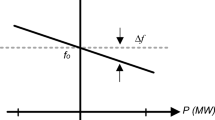Abstract
The pollution of the common connection point (CCP) in the power grid is the result of the interaction of multiple harmonic sources. In order to more accurately and fairly divide the harmonic responsibility and harmonic influence of each harmonic source at the CCP, a comprehensive evaluation method considering the user’s harmonic tolerance and grid loss is proposed. Through power flow calculation and correlation analysis, the influence degree of multi-harmonic sources on the common connection point is divided. Considering the degree of harmonic tolerance of general users on the user side and the network loss factors on the grid side, the multi-harmonic source access distribution network is comprehensively evaluated. Combined with the power flow calculation results and the harmonic compatibility level of the distribution network, a comprehensive evaluation index is formulated. This method can objectively evaluate the influence degree of the harmonic source on the distribution network, and has certain guiding significance for the location selection of the harmonic source access to the distribution network, the harmonic responsibility allocation of the multi-harmonic source access to the distribution network, and the subsequent harmonic control.
Access this chapter
Tax calculation will be finalised at checkout
Purchases are for personal use only
Similar content being viewed by others
References
Shao, Z., Haobo, X., et al.: Harmonic problems in a new energy power grid[J]. Power Syst. Prot. Control. 49(4) (2021)
Aill, M., CaltalotiA, C.A., et al.: A self synchronizing instrument for harmonic source detection in power systems[J]. IEEE Trans. Instrum. Meas. 54(1), 15–23 (2015)
Mceachern, A., Grady, W.M., Moncrief, W.A., et al.: Revenue and harmonics: an evaluation of some proposed rate structures[J]. IEEE Trans. Power Deliv. 10(1), 474–482 (1995)
Liu, Z., Yonghai, X., et al.: Research status and prospect of harmonic responsibility quantitative evaluation method under new energy integration[J]. Electr. Power Autom. Equipment. 40(11) (2020)
Liu, X., Wang, H., et al.: Application of critical impedance method in harmonic source detecting in distribution systems[J]. Autom. Electr. Power Syst. 31(14), 76–80 (2007)
Balci, M.E., Hocaoglu, M.H.: Quantitative comparison of power decompositions[J]. EPSR. 78(3), 318–329 (2008)
Ferrero, A., Menchetti, A., Sasdelli, R.: Measurement of the electric power quality and related problems[J]. ETEP. 6(6), 401–406 (2006)
Wang, L., Xiao, X., et al.: A distortion power based assessment index and method of harmonic contribution of nonlinear loads[J]. Power System Prot. Contr. 45(9), 41–47 (2017)
Dai, S., Yang, J., Li, Q.: An incentive energy measurement method based on harmonic power decomposition strategy[J]. Power Syst. Prot. Contr. 44(1), 111–116 (2016)
Zhang, Y., Wang, Y., et al.: Determination method of user harmonic responsibility based on correlation analysis of monitoring data[J]. Autom. Electr. Power Syst. 44(2), 189–197 (2020)
Wang, Y., Zang, T., et al.: Harmonic contribution partition of multiple harmonic sources considering background harmonic voltage fluctuation[J]. Autom. Electr. Power Syst. 39(18), 55–61 (2015)
Wei, G., Qiu, H., et al.: Waveform matching based method for harmonic contribution determination[J]. Autom. Electr. Power Syst. 41(2), 129–134 (2017)
Lin, S., Li, Y., et al.: System harmonic impedance estimation based on improved FastICA and partial least squares[J]. Power Syst. Technol. 42(1), 308–314 (2018)
Ma, Z., Xu, Z., et al.: Harmonic contributions determination on condition of changing background harmonic impedance[J]. Electr. Meas. Instrum. 53(23), 78–83+89 (2016)
Sha, H., Mei, F., Zhang, C., et al.: Multi-harmonic sources harmonic contribution determination based on data filtering and cluster analysis[J]. IEEE Access. 7, 85276–85285 (2019)
Author information
Authors and Affiliations
Editor information
Editors and Affiliations
Rights and permissions
Copyright information
© 2024 The Author(s), under exclusive license to Springer Nature Switzerland AG
About this chapter
Cite this chapter
Li, C., Zheng, Z. (2024). A Harmonic Impact Assessment Method for Multiple Harmonic Sources Connected to Distribution Network. In: Chen, L. (eds) Advances in Clean Energy Systems and Technologies. Green Energy and Technology. Springer, Cham. https://doi.org/10.1007/978-3-031-49787-2_15
Download citation
DOI: https://doi.org/10.1007/978-3-031-49787-2_15
Published:
Publisher Name: Springer, Cham
Print ISBN: 978-3-031-49786-5
Online ISBN: 978-3-031-49787-2
eBook Packages: EnergyEnergy (R0)




